Balbharti Maharashtra State Board 11th Biology Important Questions Chapter 8 Plant Tissues and Anatomy Important Questions and Answers.
Maharashtra State Board 11th Biology Important Questions Chapter 8 Plant Tissues and Anatomy
Question 1.
How plant tissues are classified on the basis of their ability to divide?
Answer:
Plant tissues are classified into meristematic tissues and permanent tissues based on their ability to divide.
![]()
Question 2.
Identify the labels i, ii and iii in the given figure of meristematic tissue and write its characteristics.

Answer:
1. Cell wall
2. Nucleus
3. Cytoplasm
Characteristics of meristematic tissue:
- It is a group of young, immature cells.
- These are living cells with ability to divide in the regions where they are present.
- These are polyhedral or isodiametric in shape without intercellular spaces.
- Cell wall is thin, elastic and mainly composed of cellulose.
- Protoplasm is dense with distinct nucleus at the centre and vacuoles if present, are very small.
- Cells show high rate of metabolism.
Question 3.
With the help of neat and labelled diagram explain the classification of meristematic tissue based on its position.
Answer:
Classification of meristematic tissue based on its position:
1. Apical meristem:
a. It is produced from promeristem and forms growing point of apices of root, shoot and their lateral branches.
b. It brings about increase in length of plant body and is called as apical initials.
c. Shoot apical meristem is terminal in position whereas in root it is subterminal i.e. located behind the root cap.
2. Intercalary meristem:
a. Intercalary meristematic tissue is present in the top or base area of node.
b. Their activity is mainly seen in monocots.
c. These are short lived.
3. Lateral meristem:
a. It is present along the sides of central axis of organs.
b. It takes part in increasing girth of stem or root, e.g. Intrafascicular cambium.
c. It is found in vascular bundles of gymnosperms and dicot angiosperms.
![]()
Question 4.
Complete the given table representing types of meristematic tissue based on its function.
Answer:
| Types of meristematic tissue | Function |
| 1. Protoderm | It is found in young growing region of a plant forming a protective covering like epidermis around the various organs. |
| 2. Procambium | It is involved in developing primary vascular tissue. |
| 3. Ground meristem | It forms structures like cortex, endodermis, pericycle, medullary rays, pith. |
Question 5.
Which are the simple permanent tissues in plants?
Answer:
Parenchyma, Collenchyma and Sclerenchyma are the simple permanent tissues in plants.
Question 6.
Complete the given chart by giving characteristics of following tissues:
Answer:
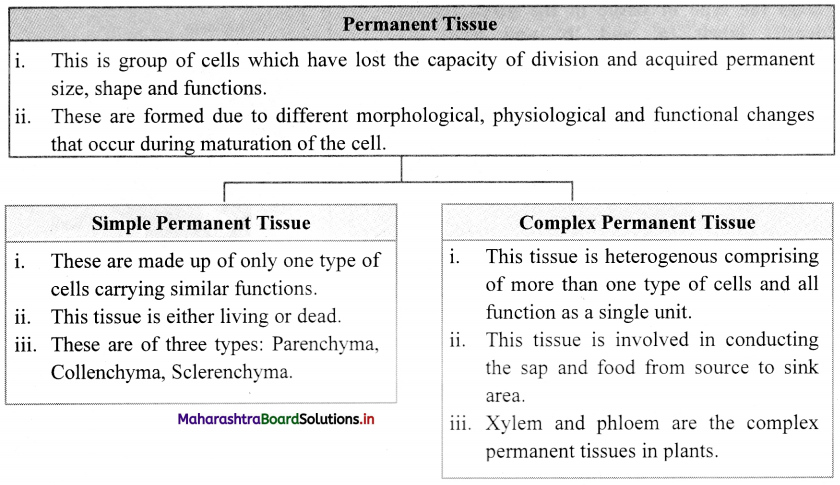
Question 7.
Name the type of tissue in the given figure, identify labels ‘a’ and ‘b’ and write its characteristics.

Answer:
1. The given figure represents simple permanent tissue i.e. Parenchyma.
2. a: Vacuole, b: Intercellular air spaces.
Characteristics of parenchyma: Parenchyma:
- It is a type of simple permanent tissue.
- Cells in this tissue are thin walled, isodiametric, round, oval to polygonal or elongated in shape.
- Cell wall is composed of cellulose.
- Cells are living with prominent nucleus and cytoplasm with large vacuole.
- Parenchyma has distinct intercellular spaces. Sometimes, cells may show compact arrangement.
- The cytoplasm of adjacent cells is interconnected through plasmodesmata and thus forms a continuous tissue.
- This is less specialized permanent tissue.
- Occurrence:
These cells are distributed in all the parts of a plant body viz. epidermis, cortex, pericycle, pith, mesophyll cells, endosperm, xylem and phloem. - Functions:
These cells store food, water, help in gaseous exchange, increase buoyancy, perform photosynthesis and different functions in plant body. - Dedifferentiation in parenchyma cells develops vascular cambium and cork cambium at the time of
secondary growth.
![]()
Question 8.
Identify the type of tissue shown in the given figure and write its characteristics.
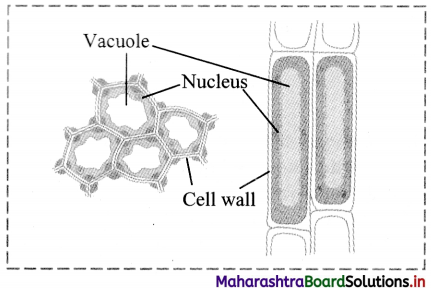
Answer:
The given figure represents Collenchyma tissue.
Characteristics of Collenchyma:
- It is a simple permanent tissue made up of living cells.
- The cell wall is cellulosic but shows uneven deposition of cellulose and pectin especially at comers.
- The walls may show presence of pits.
- Cells are similar like parenchyma, containing cytoplasm, nucleus and vacuoles but small in size and without intercellular spaces. Thus, the cells appear to be compactly packed.
- The cells are either circular, oval or angular in transverse section.
Function:
Collenchyma is a living mechanical tissue and serves different functions in plants.
a. It gives mechanical strength to young stem and parts like petiole of leaf.
b. It allows bending and pulling action in plant parts and also prevents tearing of leaf.
c. It also allows growth and elongation of organs.
d. Collenchyma is usually absent in monocots and roots of dicot plant.
Question 9.
With the help of neat and labelled diagrams explain the Sclerenchyma Tissue.
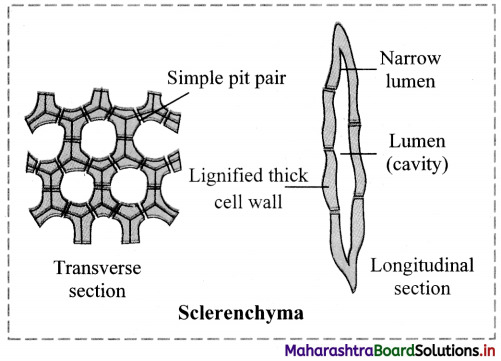
Answer:
Sclerenchyma Tissue:
- It is simple permanent tissue made up of compactly arranged thick walled dead cells.
- The cells are living at the time of production but at maturity they become dead.
- Cells are devoid of cytoplasm.
- Their walls are thickened due to uniform deposition of lignin.
- Cells remain interconnected through several pits.
Types of Sclerenchyma:
Sclerenchyma cells are categorized into two types on the basis of their size and shape as
fibres and sclereids:
a. Fibres:
Fibres are thread-like, elongated and narrow structures with tapering and interlocking end walls. Fibres are mostly in bundles. Pits are narrow, unbranched and oblique. They provide mechanical strength.
b. Sclereids:
Sclereids are usually broad, with blunt end walls.
These occur singly or in loose groups and their pits are deep branched and straight.
These are developed due to secondary thickening of parenchyma cells and provides stiffness only.
Functions:
a. This tissue functions as the main mechanical tissue.
b. It permits bending, shearing and pulling.
c. It gives rigidity to leaves and prevents it from falling.
d. It also gives rigidity to epicarps and seeds.
![]()
Question 10.
Give a brief account of water-conducting tissues in higher plants.
Answer:
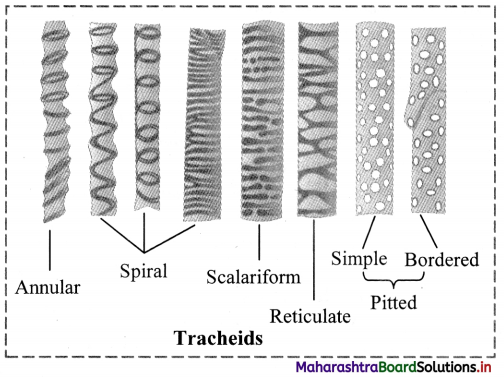
1. Xylem is the water-conducting tissue in higher plants. It is a dead complex tissue.
It also provides mechanical strength to the plant body.
Components of xylem are tracheids, vessels, xylem parenchyma and xylem fibres.
2. Tracheids:
a. These are elongated, tubular and dead cells (without protoplasm).
b. The ends are oblique and tapering.
c. The cell walls is unevenly thickened and lignified. This provides mechanical strength.
d. Tracheids contribute 95% of wood in gymnosperms and 5% in angiosperms.
e. The different types of thickening patterns are seen on their walls such as annular (in the form of rings), spiral (in the form of spring/helix), scalariform (ladder like) and pitted (small circular area). Pitted is the most advanced type of thickening which may be simple or bordered.
3. Vessels:
a. Vessels are longer than tracheids with perforated or dissolved ends and formed by union of several vessels end to end.
b. These are involved in conduction of water and minerals.
c. Their lumen is wider than tracheids and the thickening is due to lignin and similar to tracheids.
d. In monocots, vessels are rounded where as they are angular in dicot angiosperms.
e. The first formed xylem vessels (protoxylem) are small and have either annular or spiral thickenings while latter formed xylem vessels are larger (metaxylem) and have reticulate or pitted thickenings.
f. When protoxylem is arranged towards pith and metaxylem towards periphery it is called as endarch
e. g. in stem and when the position is reversed as in the roots is called as exarch.
4. Xylem parenchyma:
a. Xylem parenchyma cells are small associated with tracheids and vessels.
b. This is the only living tissue among this complex tissue.
c. The function is to store food (starch) and sometimes tannins.
d. Xylem parenchyma are involved in lateral or radial conduction of water or sap.
5. Xylem fibres:
a. Xylem fibres are sclerenchymatous cells and serve mainly mechanical support. These are called wood fibres.
b. These are also elongated, narrow and spindle shaped.
c. Cells are tapering at both the ends and their walls are lignified.
Question 11.
Draw neat and labelled diagram of xylem tissue and vascular bundle.
Answer:
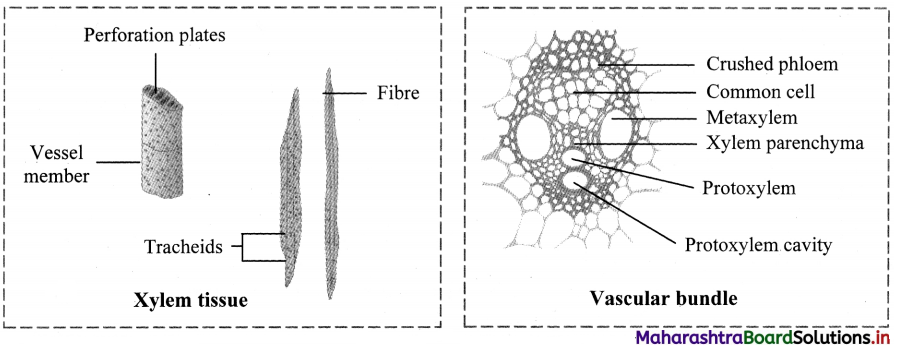
Question 12.
Match the following.
| Column I | Column II |
| 1. Protoxylem | (a) Xylem with larger vessels |
| 2. Endarch Xylem | (b) Protoxylem arranged towards pith |
| 3. Metaxylem | (c) Metaxylem arranged towards pith |
| 4. Exarch xylem | (d) First formed xylem vessels |
Answer:
| Column I | Column II |
| 1. Protoxylem | (d) First formed xylem vessels |
| 2. Endarch Xylem | (b) Protoxylem arranged towards pith |
| 3. Metaxylem | (a) Xylem with larger vessels |
| 4. Exarch xylem | (c) Metaxylem arranged towards pith |
![]()
Question 13.
Describe the structure of phloem.
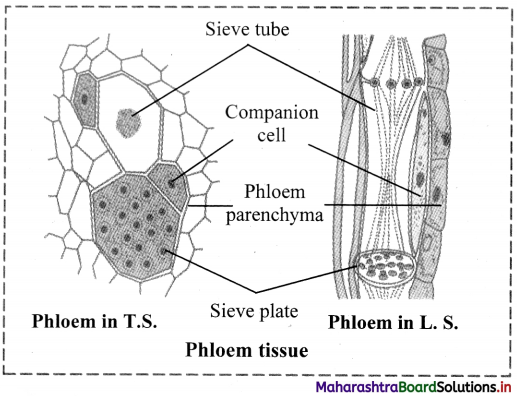
Answer:
Structure of phloem:
1. Phloem is a living tissue. It is also called as bast.
It is responsible for conduction of organic food material from source (generally leaf) to a sink (other plant parts).
On the basis of origin, it can be protophloem (first formed) and metaphloem (latterly formed).
It is composed of sieve elements (sieve cells and sieve tubes), companion cells, phloem parenchyma and phloem fibres.
2. Sieve elements:
a. Sieve tubes are long tubular conducting channel of phloem.
b. These are placed end to end with bulging at end walls.
c. The sieve tube has sieve plate formed by septa with small pores.
d. The sieve plates connect protoplast of adjacent sieve tube cells.
e. The sieve tube cell is a living cell with a thin layer of cytoplasm, but loses its nucleus at maturity.
f. The sieve tube cell is connected to companion cell through phloem parenchyma by plasmodesmata.
g. Sieve cells are found in lower plants like pteridophytes and gymnosperms and sieve tubes are found in angiosperms.
h. The cells are narrow, elongated with tapering ends and sieve area located laterally.
3. Companion cells:
a. These are narrow elongated and living.
b. Companion cells are laterally associated with sieve tube elements.
c. Companion cells have dense cytoplasm and prominent nucleus.
d. Nucleus of companion cell regulates functions of sieve tube cells through simple pits.
e. From origin point of view, sieve tube cells and companion cell are derived from same cell. Death of the one result in death of the other type.
4. Phloem parenchyma:
a. Cells of phloem parenchyma are living, elongated found associated with sieve tube and companion cells.
b. Their chief function is to store food, latex, resins, mucilage, etc.
c. The cells carry out lateral conduction of food material.
d. These cells are absent in most of the monocots.
5. Phloem fibres (Bast fibres):
a. Phloem fibres are the only dead tissue among this unit.
b. They are sclerenchymatous.
c. They are generally absent in primary phloem, but present in secondary phloem.
d. These cells have with lignified walls and provide mechanical support.
e. They are used in making ropes and rough clothes.
Question 14.
Draw a diagram of phloem.
Answer:
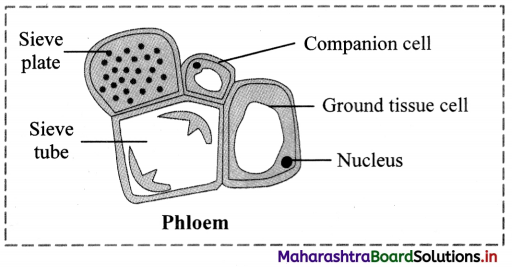
Question 15.
Name the types of tissue systems in plants.
Answer:
The types of tissue systems in plants are epidermal tissue system, ground tissue system and vascular tissue system.
![]()
Question 16.
Write a short note on Epidermis.
Answer:
Epidermis:
- It is the outermost protective cell layer made up of compactly arranged cells without intercellular spaces.
- Cells show presence of central large vacuole, thin cytoplasm and a nucleus.
- The outer side of the epidermis is often covered with a waxy thick layer called the cuticle which prevents the loss of water.
- Root epidermis (Epiblema) has root hairs. These are unicellular, elongated and involved in absorption of sap from the soil.
- In stem, epidermal hairs are called trichomes. These are generally multicellular, branched or unbranched, stiff or soft or even secretory. These help in preventing water loss due to transpiration.
Question 17.
Draw a diagram representing epidermal tissue system.
Answer:

Question 18.
Write a short note on Structure of stomata.
Answer:
Structure of stomata:
- Small gateways in the epidermal cells are called as stomata.
- Stoma is controlled or guarded by specially modified cells called guard cells.
- These guard cells may be kidney shaped (dicot) or dumbbell shaped (monocot), collectively called as stomata.
- Guard cells have chloroplasts to carry out photosynthesis.
- Change in turgor pressure of guard cells causes opening and closing of stomata, which enables exchange of gases and water vapour.
- Stomata are further covered by subsidiary cells.
- Stoma, guard cells and subsidiary cells form a unit called stomatal apparatus.
Question 19.
Write the information related to diagrams given below.
Answer:
1. The given diagram represents stoma in dicot leaf.
[Note: We have given additional label of ‘chloroplast ’for better understanding of students]
2. Structure of stomata:
- Small gateways in the epidermal cells are called as stomata.
- Stoma is controlled or guarded by specially modified cells called guard cells.
- These guard cells may be kidney shaped (dicot) or dumbbell shaped (monocot), collectively called as stomata.
- Guard cells have chloroplasts to carry out photosynthesis.
- Change in turgor pressure of guard cells causes opening and closing of stomata, which enables exchange of gases and water vapour.
- Stomata are further covered by subsidiary cells.
- Stoma, guard cells and subsidiary cells form a unit called stomatal apparatus.
Question 20.
Explain the term ground tissue.
Answer:
Ground tissue:
- All the plant tissues excluding epidermal and vascular tissue is ground tissue.
- It is made up of simple permanent tissue e.g. parenchyma.
- It is present in cortex, pericycle, pith and medullary rays in the primary stem and root.
- Collenchyma and sclerenchyma in the hypodermis and chloroplasts containing mesophyll tissue in leaves is also ground tissue.
Question 21.
Describe various types of vascular bundles.
Answer:
Vascular bundles occur in the form of distinct patches of the complex tissue viz. Xylem and Phloem. On the basis of their arrangement in the plant body they are classified as follows:
1. Radial vascular bundles:
When the complex tissues (xylem and phloem) are situated separately on separate radius as separate bundle, vascular bundle is called Radial vascular bundle. This is a common feature of roots.
2. Conjoint vascular bundles:
When the complex tissue (xylem and phloem) is collectively present as neighbours of each other on the same radius, vascular bundle is called Conjoint vascular bundle.
They are of two types:
a. Collateral vascular bundle:
In this type of vascular bundle, xylem lies inwards and the phloem lies outwards.
These bundles may be further of open type (secondary growth takes place) containing cambium in between xylem and phloem and closed type if cambium is not present (secondary growth absent).
b. Bicollateral vascular bundle:
When phloem is present in a vascular bundle on both the sides of xylem and intervening cambium tissue, it is called bicollateral vascular bundle. It is a feature of family Cucurbitaceae.
3. Concentric vascular bundle:
a. When one vascular tissue is completely encircling the other, it is called as concentric vascular bundle.
b. When phloem is encircled by xylem, it is called as leptocentric vascular bundle, whereas when xylem is encircled by phloem, it is called as hadrocentric vascular bundle.
c. When xylem is encircled by phloem on both faces, it is called as amphicribral vascular bundle. When phloem is encircled by xylem on both faces it is called as amphivasal vascular bundle.
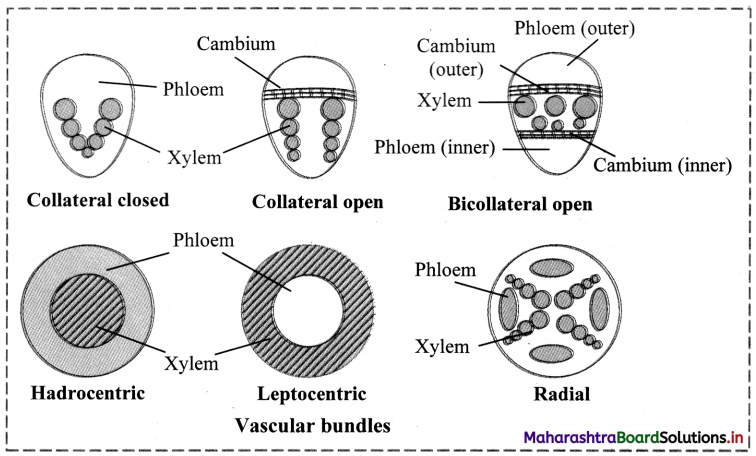
![]()
Question 22.
Explain how formation of cambial ring occurs in dicot stem.
Answer:
- The cambium present between the primary xylem and primary phloem of a vascular bundle is called intrafascicular cambium.
- With the onset of favourable season, meristematic cells of intrafascicular cambium become active.
- Simultaneously, the ray parenchyma cells, both fusiform initials and ray initials become meristematic. This is known as dedifferentiation.
- These form patch of cambial cells (meristematic cells) in between the adjacent bundles and produce interfascicular cambium.
- Both intrafascicular and interfascicular cambium join and form a complete ring, known as the cambial ring. This is possible because they lie in one plane.
Question 23.
‘Secondary growth is observed in most of the dicot and gymnospermic root.’ State whether the given statement is true or false and justify your answer.
Answer:
- The given statement is true.
- Secondary growth is observed in most of the dicot and gymnospermic root by producing secondary vascular tissue and periderm.
- Secondary growth is produced by vascular cambium and cork cambium respectively.
- Conjunctive parenchyma cells present on the inner edges of primary phloem bundles become meristematic.
- These cells add secondary xylem and secondary phloem on the inner and outer side respectively which results in secondary growth.
Question 24.
Differentiate between heartwood and sap wood.
Answer:
| Heartwood | Sap wood |
| 1. It is central region of secondary xylem (wood). | It is the peripheral region of secondary xylem (wood). |
| 2. It is darker in colour due to deposition of oils, gums, resins, tannins, etc | It is lighter in colour and without any depositions. |
| 3. It is non- functional part of secondary xylem. | It is functional part of secondary xylem. |
| 4. It is resistant to pathogens. | It is more susceptible to pathogens |
| 5. It is not involved in conduction of sap. | It is involved in conduction of sap. |
| 6. It is also called as duramen. | It is also called as alburnum. |
Question 25.
What are tyloses?
Answer:
Tyloses:
1. Tracheary elements of heartwood are plugged by in-growth of adjacent parenchyma cells are known as tyloses.
2. Tyloses are fdled by oils, gums, resins, tannins called as extractives.
Question 26.
Explain how periderm is formed?
Answer:
Formation of periderm:
As the stem increase in diameter due to activity of vascular cambium, the outer cortical and epidermal layer get ruptured. Thus, it becomes necessaiy to replace these cells by new cells.
- Phellogen (cork cambium) develops in extrastelar region (cortex region) of the stem.
- The outer cortical cells of cortex become meristematic and produce a layer of thin walled, rectangular cells. These cells cut off new cells on both sides.
- The cells produced on outer side develop phellem (cork), whereas on the inner side produce phelloderm (secondary cortex).
- The cork is impervious in nature and does not allow entry of water due to suberized walls. Secondary cortex is parenchymatous in nature.
- Phellogen, phellem and phelloderm constitute periderm.
Question 27.
Explain the given terms:
1. Bark
2. Lenticels
3. Anomalous secondary growth
Answer:
1. Bark:
a. Bark is non-technical term referring to all cell types found external to vascular cambium including secondary phloem.
b. Bark of early season is soft and of the late season is hard.
2. Lenticels:
a. Lenticels are aerating pores present as raised scars on the surface of bark.
b. These are portions of periderm, where phellogen activity is more.
c. Lenticels are meant for gaseous and water vapour exchange.
3. Anomalous secondary growth:
a. Monocot stems lack cambium hence secondary growth does not take place.
b. However, accessory cambium development in plants like, Dracaena, Agave, Palms and root of sweet potato shows presence of secondary growth. This is called as anomalous secondary growth.
![]()
Question 28.
With the help of neat and labelled diagram explain the anatomy of dicot root.
Answer:
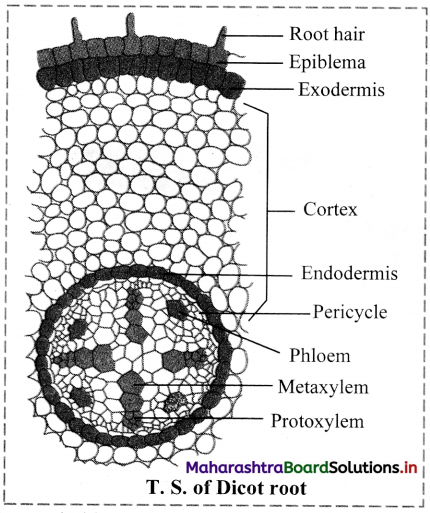
The transverse section of a typical dicotyledonous root shows following anatomical features:
1. Epiblema: It is the outermost single layer of cells without cuticle. Some epidermal cells prolong to form unicellular root hairs.
2. Cortex: It is made up of many layers of thin walled parenchyma cells. Cortical cells store food and water.
3. Exodermis: After the death of epiblema, outer layer of cortex become cutinized and is called Exodermis.
4. Endodermis:
The innermost layer of cortex is called Endodermis.
The cells are barrel-shaped and their radial walls bear Casparian strip or Casparian bands composed of suberin. Near the protoxylem, there are unthickened passage cells.
5. Stele: It consists of pericycle, vascular bundles and pith.
a. Pericycle: Next to the endodermis, there is a single layer of thin walled parenchyma cells called pericycle. It forms outermost layer of stele or vascular cylinder.
b. Vascular bundle: Vascular bundles are radial. Xylem and Phloem occur in separate patches arranged on alternate radii. Xylem is exarch in root that means protoxylem vessels are towards periphery and metaxylem elements are towards centre. Xylem bundles vary from two to six number, i.e. they may be diarch, triarch, tetrarch, etc.
Connective tissue: A parenchymatous tissue is present in between xylem and phloem.
c. Pith: The central part of stele is called pith. It is narrow and made up of parenchymatous cells, with or without intercellular spaces.
6. At a later stage cambium ring develops between the xylem and phloem causing secondary growth.
Question 29.
With the help of neat and labelled diagram explain the anatomy of monocot root.
Answer:
The transverse section of a typical monocotyledonous root shows following anatomical features:
1. Epiblema: It is the outermost single layer of cells without cuticle. Some epidermal cells prolong to form unicellular root hairs.
2. Cortex: It is made up of many layers of thin walled parenchyma cells. Cortical cells store food and water.
Endodermis: It is innermost layer of cortex. The cells of endodermis are thick walled except the passage cells which lie just opposite to the protoxylem.
Stele: It consists of pericycle, vascular bundles and pith.
a. Pericycle: Pericycle is present below the endodermis.
b. Vascular bundle: Vascular bundles are radial. Xylem and Phloem occur in separate patches arranged on alternate radii. Xylem is exarch in root that means protoxylem vessels are towards periphery and metaxylem elements are towards centre. Polyarch condition of xylem is observed, (xylem bundles are more than six).
Pith: Pith is large and well developed.
Secondary growth does not occur due to absence of cambium.
![]()
Question 30.
What is polyarch condition of root?
Answer:
Polyarch condition is the one in which roots possess more than six xylem bundles.
Question 31.
Explain in detail anatomy of sunflower stem.
Answer:
A transverse section of sunflower (dicot) stem shows the following structures:
1. Epidermis: It is a single, outermost layer with multicellular outgrowth called trichomes. A layer of cuticle
is usually present towards the outer surface of epidermis.
2. Cortex: Cortex is situated below the epidermis and is usually differentiated into three regions namely, hypodermis, general cortex and endodermis.
a. Hypodermis: It is situated just below the epidermis and is made of 3-5 layers of collenchymatous cells. Intercellular spaces are absent.
b. General cortex: It is made up of several layers of large parenchymatous cells with intercellular spaces.
c. Endodermis: It is an innermost layer of cortex which is made up of barrel shaped cells. It is also called starch sheath, as it is rich in starch grain.
3. Stele: It is differentiated into pericycle, vascular bundles and pith.
a. Pericycle: It is the outermost layer of vascular system situated between the endodermis and vascular bundles. In sunflower, it is multi-layered and also called hard bast.
b. Vascular bundles: Vascular bundles are conjoint, collateral, open, and are arranged in a ring. Each one is composed of xylem, phloem and cambium. Xylem is endarch. A strip of cambium is present between xylem and phloem.
c. Pith: It is situated in the centre of the young stem and is made up of large-sized parenchymatous cells with conspicuous intercellular spaces.
Question 32.
With the help of neat and labelled diagram explain the anatomy of maize stem.
Answer:
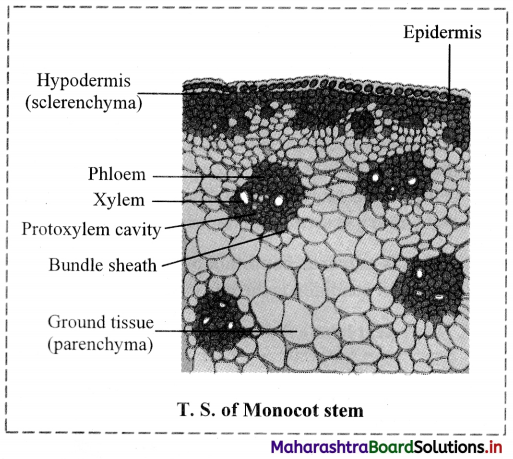
A transverse section of maize (monocot) stem shows the following structures:
- Epidermis: It is single layered and without trichomes.
- Hypodermis: It is sclerenchymatous.
- Ground tissue: It consists of thin walled parenchyma cells. It extends from hypodermis to the centre. It is not differentiated into cortex, endodermis, pericycle and pith.
- Vascular bundles: Vascular bundles are numerous and are scattered in ground tissue. Each vascular bundle is surrounded by a sclerenchymatous bundle sheath. Vascular bundles are conjoint, collateral and closed (without cambium). Xylem is endarch and shows lysigenous cavity.
- Pith: Pith is absent.
Question 33.
With the help of a neat and labelled diagram, describe the internal structure of dorsiventral leaf.
Answer:
1. Structure of dorsiventral leaf: The mesophyll tissue is differentiated into palisade and spongy parenchyma in a dorsiventral leaf. This type is very common in dicot leaf. The different parts of this leaf are as follows:
2. Upper epidermis: It consists of a single layer of tightly packed rectangular, barrel shaped, parenchymatous cells which are devoid of chloroplast. A distinct layer of cuticle lies on the outside of the epidermis. Stomata are generally absent.
3. Mesophyll: Between upper and lower epidermis, there is chloroplast-containing photosynthetic tissue called mesophyll It is differentiated into Palisade parenchyma and Spongy parenchyma.
a. Palisade parenchyma:
Palisade parenchyma is present below upper epidermis and consists of closely packed elongated cells. The cells contain abundant chloroplasts and help in photosynthesis.
b. Spongy parenchyma:
Spongy parenchyma is present below palisade tissue and consists of loosely arranged irregularly shaped cells with intercellular spaces. The spongy parenchyma cells contain chloroplast and are in contact with the atmosphere through stomata.
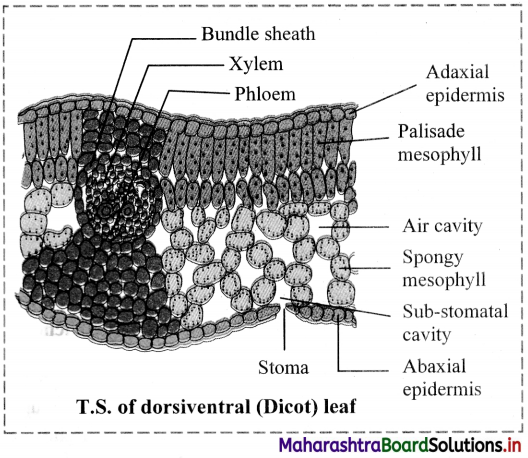
4. Vascular system: It is made up of a number of vascular bundles of varying size depending upon the venation. Each one is surrounded by a thin layer of parenchymatous cells called bundle sheath. Vascular bundles are closed. Xylem lies towards upper epidermis and phloem towards lower epidermis. Cambium is absent, hence there is no secondary growth in the leaf.
5. Lower epidermis: It consists of a single layer of compactly arranged rectangular, parenchymatous cells. A thin layer of cuticle is also present. The lower epidermis contains a large number of microscopic pores called stomata. There is an air-space called substomatal chamber at each stoma.
![]()
Question 34.
With the help of a neat labelled diagram, describe the anatomy of isobilateral leaf.
Answer:
The parts of isobilateral leaf are as follows:

1. Epidermis:
It is single layered, present on both sides of the leaf.
It consists of compactly arranged rectangular transparent parenchymatous cells.
Both the surfaces contain stomata.
Both the surfaces have a distinct layer of cuticle.
2. Mesophyll:
Mesophyll is not differentiated into palisade and spongy tissue.
3. Vascular bundle:
These are conjoint, collateral and closed.
Question 35.
Compare between dorsiventral and isobilateral leaf.
Answer:
| Dorsiventral leaf | Isobilateral leaf |
| 1. Dorsiventral Leaf is very common in dicotyledonous plants. | Isobilateral leaf is very common in monocotyledonous plants. |
| 2. In this mesophyll tissue is differentiated into palisade and spongy parenchyma. | In this mesophyll tissue is not differentiated into palisade and spongy parenchyma. |
| 3. The leaves are commonly horizontal in orientation with distinct upper and lower surfaces. The upper surface which faces the sun is darker than the lower surface. | In this leaf both the surfaces are equally illuminated as both the surface can face the sun, and show similar structure. The two surfaces are equally green. |
| 4. Stomata is absent on the upper surface of these leaves. | Stomata is present on both the upper and lower surfaces of these leaves. |
Question 36.
Distinguish between anatomy of dicot root and monocot root.
Answer:
| Anatomy of dicot root | Anatomy of monocot root |
| 1. Pith is narrow. | Pith is large and well developed. |
| 2. Diarch, triarch or tetrarch condition can be observed. (Xylem bundles vary from two to six number) | Polyarch condition is observed, (xylem bundles are more than six) |
| 3. Cambium is formed in later stage between xylem and phloem which causes secondary growth. | Secondary growth is absent. |
![]()
Question 37.
Distinguish between anatomy of dicot stem and monocot stem.
Answer:
| Anatomy of Dicot stem | Anatomy of Monocot stem |
| 1. Epidermis shows presence of multicellular trichomes. | Epidermis is without trichomes. |
| 2. Hypodermis is made up of collenchymatous cells. | Hypodermis is made up of sclerenchymatous cells. |
| 3. Medullary rays are present between vascular bundles. | Medullary rays are absent. |
| 4. Vascular bundles are arranged in the form of a ring. | Vascular bundles are scattered in the ground tissue. |
| 5. It is conjoint, collateral and open (Cambium present) | They are conjoint, collateral and closed (cambium is absent). |
| 6. Vascular bundle is not surrounded by a sclerenchymatous bundle sheath. | Vascular bundle is surrounded by a sclerenchymatous bundle sheath. |
| 7. Secondary growth takes place due to presence of cambium. | Secondary growth does not occur due to absence of cambium. |
| 8. Pith is present. | Pith is absent. |
Question 38.
Apply Your Knowledge
Question 1.
Which plant part would show the following:
- Radial vascular bundles.
- Large and well-developed pith.
- Differentiation of mesophyll into palisade and spongy tissue.
- Presence of stomata on both upper and lower epidermis.
Answer:
- Root
- Monocot root and Dicot stem,
- Dicot leaf
- Monocot leaf
Question 2.
When a tree is debarked, which tissues are removed?
Answer:
The bark is made up of tissues like cork, cork cambium and secondary cortex, which are removed when a tree is debarked.
Question 3.
While eating fruits like pear or guava, it feels gritty. What gives stiffness to these fruits?
Answer:
Sclereids are found in pulp of fruits like pear and guava which gives them stiffness and thus we feel gritty while eating these fruits.
![]()
Question 39.
Quick Review

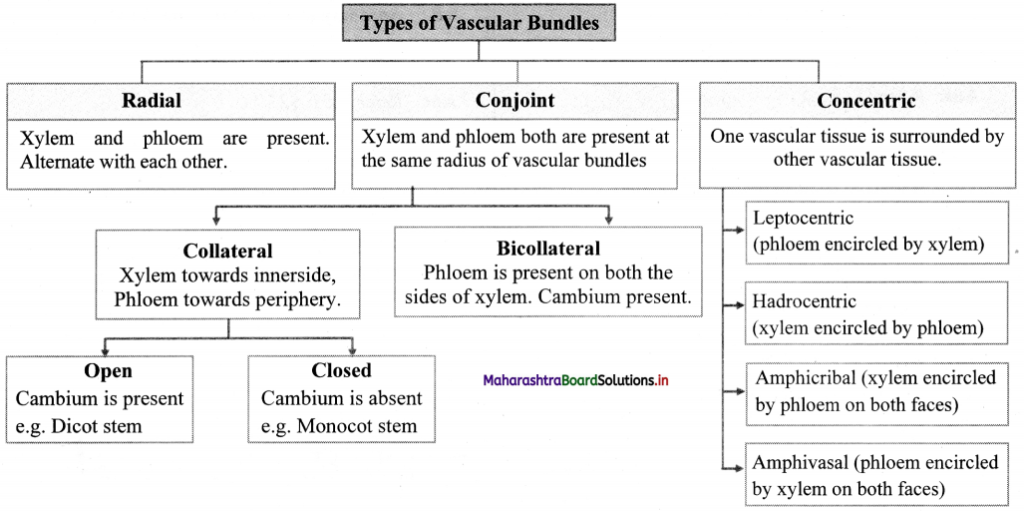
Question 40.
Exercise
Question 1.
Define tissue.
Answer:
A group of cells having essentially a common function and origin is called as tissue.
Question 2.
Classify the meristematic tissue based on its origin.
Answer:
Classification of meristematic tissue on the basis of origin:
1. Promeristem / Primordial meristem:
a. It is also called as embryonic meristem.
b. It usually occupies very minute area at the tip of root and shoot.
2. Primary meristem:
a. It originates from the primordial meristem and occurs in the plant body from the beginning, at the root and shoot apices.
b. Cells are always in active state of division and give rise to permanent tissues.
3. Secondary meristem:
a. These tissues develop from living permanent tissues during later stages of plant growth hence are called as secondary meristems.
b. This tissue occurs in the mature regions of root and shoot of many plants.
c. Secondary meristem is always lateral (to the central axis) in position e.g. Fascicular cambium, inter fascicular cambium, cork cambium.
![]()
Question 3.
Explain in detail classification of meristematic tissue based on its position.
Answer:
Classification of meristematic tissue based on its position:
1. Apical meristem:
a. It is produced from promeristem and forms growing point of apices of root, shoot and their lateral branches.
b. It brings about increase in length of plant body and is called as apical initials.
c. Shoot apical meristem is terminal in position whereas in root it is subterminal i.e. located behind the root cap.
2. Intercalary meristem:
a. Intercalary meristematic tissue is present in the top or base area of node.
b. Their activity is mainly seen in monocots.
c. These are short lived.
3. Lateral meristem:
a. It is present along the sides of central axis of organs.
b. It takes part in increasing girth of stem or root, e.g. Intrafascicular cambium.
c. It is found in vascular bundles of gymnosperms and dicot angiosperms.
Question 4.
Give any two examples of secondary meristematic tissue.
Answer:
Secondary meristem is always lateral (to the central axis) in position e.g. Fascicular cambium, inter fascicular cambium, cork cambium.
Question 5.
Draw a diagram of meristematic cells.
Answer:
1. Cell wall
2. Nucleus
3. Cytoplasm
Characteristics of meristematic tissue:
- It is a group of young, immature cells.
- These are living cells with ability to divide in the regions where they are present.
- These are polyhedral or isodiametric in shape without intercellular spaces.
- Cell wall is thin, elastic and mainly composed of cellulose.
- Protoplasm is dense with distinct nucleus at the centre and vacuoles if present, are very small.
- Cells show high rate of metabolism.
![]()
Question 6.
Write a short note on tracheids.
Answer:
Tracheids:
a. These are elongated, tubular and dead cells (without protoplasm).
b. The ends are oblique and tapering.
c. The cell walls is unevenly thickened and lignified. This provides mechanical strength.
d. Tracheids contribute 95% of wood in gymnosperms and 5% in angiosperms.
e. The different types of thickening patterns are seen on their walls such as annular (in the form of rings), spiral (in the form of spring/helix), scalariform (ladder like) and pitted (small circular area). Pitted is the most advanced type of thickening which may be simple or bordered.
Question 7.
Describe parenchyma in detail.
Answer:
Cell is the component that brings about important processes in the living organisms.
Question 8.
Describe the structure of xylem in detail.
Answer:
1. Xylem is the water conducting tissue in higher plants. It is a dead complex tissue.
It also provides mechanical strength to the plant body.
Components of xylem are tracheids, vessels, xylem parenchyma and xylem fibres.
2. Tracheids:
a. These are elongated, tubular and dead cells (without protoplasm).
b. The ends are oblique and tapering.
c. The cell walls is unevenly thickened and lignified. This provides mechanical strength.
d. Tracheids contribute 95% of wood in gymnosperms and 5% in angiosperms.
e. The different types of thickening patterns are seen on their walls such as annular (in the form of rings), spiral (in the form of spring/helix), scalariform (ladder like) and pitted (small circular area). Pitted is the most advanced type of thickening which may be simple or bordered.
3. Vessels:
a. Vessels are longer than tracheids with perforated or dissolved ends and formed by union of several vessels end to end.
b. These are involved in conduction of water and minerals.
c. Their lumen is wider than tracheids and the thickening is due to lignin and similar to tracheids.
d. In monocots, vessels are rounded where as they are angular in dicot angiosperms.
e. The first formed xylem vessels (protoxylem) are small and have either annular or spiral thickenings while latter formed xylem vessels are larger (metaxylem) and have reticulate or pitted thickenings.
f. When protoxylem is arranged towards pith and metaxylem towards periphery it is called as endarch
e. g. in stem and when the position is reversed as in the roots is called as exarch.
4. Xylem parenchyma:
a. Xylem parenchyma cells are small associated with tracheids and vessels.
b. This is the only living tissue among this complex tissue.
c. The function is to store food (starch) and sometimes tannins.
d. Xylem parenchyma are involved in lateral or radial conduction of water or sap.
5. Xylem fibres:
a. Xylem fibres are sclerenchymatous cells and serve mainly mechanical support. These are called wood fibres.
b. These are also elongated, narrow and spindle shaped.
c. Cells are tapering at both the ends and their walls are lignified.
Question 9.
What are Sclerenchyma fibres?
Answer:
a. Fibres:
Fibres are thread-like, elongated and narrow structures with tapering and interlocking end walls. Fibres are mostly in bundles. Pits are narrow, unbranched and oblique. They provide mechanical strength.
![]()
Question 10.
Write the functions of parenchyma cells.
Answer:
Parenchyma, Collenchyma and Sclerenchyma are the simple permanent tissues in plants.
Question 11.
Write function of collenchyma tissue.
Answer:
Function:
Collenchyma is a living mechanical tissue and serves different functions in plants.
a. It gives mechanical strength to young stem and parts like petiole of leaf.
b. It allows bending and pulling action in plant parts and also prevents tearing of leaf.
c. It also allows growth and elongation of organs.
Question 12.
Which are the different types of tracheids based on the types of thickenings on their walls?
Answer:
The different types of thickening patterns are seen on their walls such as annular (in the form of rings), spiral (in the form of spring/helix), scalariform (ladder like) and pitted (small circular area). Pitted is the most advanced type of thickening which may be simple or bordered.
Question 13.
Death of companion cell causes death of sieve tube cells and vice versa. Justify.
Answer:
Companion cells:
a. These are narrow elongated and living.
b. Companion cells are laterally associated with sieve tube elements.
c. Companion cells have dense cytoplasm and prominent nucleus.
d. Nucleus of companion cell regulates functions of sieve tube cells through simple pits.
e. From origin point of view, sieve tube cells and companion cell are derived from same cell. Death of the one result in death of the other type.
Question 14.
Which are the three types of simple permanent tissues?
Answer:
Parenchyma, Collenchyma and Sclerenchyma are the simple permanent tissues in plants.
![]()
Question 15.
Write the functions of sclerenchyma tissue.
Answer:
Functions:
a. This tissue functions as the main mechanical tissue.
b. It permits bending, shearing and pulling.
c. It gives rigidity to leaves and prevents it from falling.
d. It also gives rigidity to epicarps and seeds.
Question 16.
What are the components of xylem?
Answer:
1. Xylem is the water conducting tissue in higher plants. It is a dead complex tissue.
It also provides mechanical strength to the plant body.
Components of xylem are tracheids, vessels, xylem parenchyma and xylem fibres.
Question 17.
Name the living component of xylem.
Answer:
This is the only living tissue among this complex tissue.
Question 18.
Name the dead component of phloem.
Answer:
Phloem fibres are the only dead tissue among this unit.
Question 19.
What is closed vascular bundle?
Answer:
When cambium is not present between xylem and phloem, it is known as closed vascular bundle.
Question 20.
Describe two types of conjoint vascular bundles.
Answer:
Conjoint vascular bundles:
When the complex tissue (xylem and phloem) is collectively present as neighbours of each other on the same radius, vascular bundle is called Conjoint vascular bundle.
They are of two types:
a. Collateral vascular bundle:
In this type of vascular bundle, xylem lies inwards and the phloem lies outwards.
These bundles may be further of open type (secondary growth takes place) containing cambium in between xylem and phloem and closed type if cambium is not present (secondary growth absent).
b. Bicollateral vascular bundle:
When phloem is present in a vascular bundle on both the sides of xylem and intervening cambium tissue, it is called bicollateral vascular bundle. It is a feature of family Cucurbitaceae.
Question 21.
Write the function of trichomes.
Answer:
In stem, epidermal hairs are called trichomes. These are generally multicellular, branched or unbranched, stiff or soft or even secretory. These help in preventing water loss due to transpiration.
Question 22.
What are bicollateral vascular bundle?
Answer:
Bicollateral vascular bundle:
When phloem is present in a vascular bundle on both the sides of xylem and intervening cambium tissue, it is called bicollateral vascular bundle. It is a feature of family Cucurbitaceae.
Question 23.
Name the tissue that are not included in ground tissue.
Answer:
All the plant tissues excluding epidermal and vascular tissue is ground tissue.
![]()
Question 24.
Which type of conjoint – vascular bundles are found in members of Cucurbitaceae family?
Answer:
Bicollateral vascular bundle:
When phloem is present in a vascular bundle on both the sides of xylem and intervening cambium tissue, it is called bicollateral vascular bundle. It is a feature of family Cucurbitaceae.
Question 25.
What is concentric vascular bundle?
Answer:
Concentric vascular bundle:
a. When one vascular tissue is completely encircling the other, it is called as concentric vascular bundle.
b. When phloem is encircled by xylem, it is called as leptocentric vascular bundle, whereas when xylem is encircled by phloem, it is called as hadrocentric vascular bundle.
c. When xylem is encircled by phloem on both faces, it is called as amphicribral vascular bundle. When phloem is encircled by xylem on both faces it is called as amphivasal vascular bundle.
Question 26.
Define intrafascicular cambium.
Answer:
The cambium present between the primary xylem and primary phloem of a vascular bundle is called intrafascicular cambium.
Question 27.
What is the difference between spring wood and autumn wood?
Answer:
During favourable conditions, spring wood (early wood) is formed which has broader xylem bands, lighter colour, tracheids with thin wall and wide lumen, fibres are less in number, low density. Whereas, during unfavourable conditions, autumn wood (late wood) is formed which has narrow xylem band, darker in colour, lumen is narrow and walls are thick with abundant fibres, high density.
Question 28.
Explain how growth rings are formed in trees?
Answer:
1. Growth rings are formed due cambial activity during favourable and non-favourable climatic conditions.
2. During favourable conditions, spring wood (early wood) is formed which has broader xylem bands, lighter colour, tracheids with thin wall and wide lumen, fibres are less in number, low density. Whereas, during unfavourable conditions, autumn wood (late wood) is formed which has narrow xylem band, darker in colour, lumen is narrow and walls are thick with abundant fibres, high density.
3. Spring wood and autumn wood that appear as alternate light and dark concentric rings, constitute an annual ring or growth ring.
Question 29.
Which tissues are together called as periderm?
Answer:
Phellogen, phellem and phelloderm constitute periderm.
![]()
Question 30.
What is bark?
Answer:
Bark:
a. Bark is non-technical term referring to all cell types found external to vascular cambium including secondary phloem.
b. Bark of early season is soft and of the late season is hard.
Question 31.
What is the function of lenticels?
Answer:
Lenticels are meant for gaseous and water vapour exchange.
Question 32.
Explain the term anomalous secondary growth.
Answer:
Anomalous secondary growth:
a. Monocot stems lack cambium hence secondary growth does not take place.
b. However, accessory cambium development in plants like, Dracaena, Agave, Palms and root of sweet potato shows presence of secondary growth. This is called as anomalous secondary growth.
Question 33.
Explain in detail anatomical structure of a dicot stem.
Answer:
A transverse section of sunflower (dicot) stem shows the following structures:
1. Epidermis: It is a single, outermost layer with multicellular outgrowth called trichomes. A layer of cuticle
is usually present towards the outer surface of epidermis.
2. Cortex: Cortex is situated below the epidermis and is usually differentiated into three regions namely, hypodermis, general cortex and endodermis.
a. Hypodermis: It is situated just below the epidermis and is made of 3-5 layers of collenchymatous cells. Intercellular spaces are absent.
b. General cortex: It is made up of several layers of large parenchymatous cells with intercellular spaces.
c. Endodermis: It is an innermost layer of cortex which is made up of barrel shaped cells. It is also called starch sheath, as it is rich in starch grain.
3. Stele: It is differentiated into pericycle, vascular bundles and pith.
a. Pericycle: It is the outermost layer of vascular system situated between the endodermis and vascular bundles. In sunflower, it is multi-layered and also called hard bast.
b. Vascular bundles: Vascular bundles are conjoint, collateral, open, and are arranged in a ring. Each one is composed of xylem, phloem and cambium. Xylem is endarch. A strip of cambium is present between xylem and phloem.
c. Pith: It is situated in the centre of the young stem and is made up of large-sized parenchymatous cells with conspicuous intercellular spaces.
Question 34.
Draw neat and labelled diagrams of dicot and monocot root and differentiate between their anatomical characters.
Answer:
The transverse section of a typical dicotyledonous root shows following anatomical features:
1. Epiblema: It is the outermost single layer of cells without cuticle. Some epidermal cells prolong to form unicellular root hairs.
2. Cortex: It is made up of many layers of thin walled parenchyma cells. Cortical cells store food and water.
3. Exodermis: After the death of epiblema, outer layer of cortex become cutinized and is called Exodermis.
4. Endodermis:
The innermost layer of cortex is called Endodermis.
The cells are barrel-shaped and their radial walls bear Casparian strip or Casparian bands composed of suberin. Near the protoxylem, there are unthickened passage cells.
5. Stele: It consists of pericycle, vascular bundles and pith.
a. Pericycle: Next to the endodermis, there is a single layer of thin walled parenchyma cells called pericycle. It forms outermost layer of stele or vascular cylinder.
b. Vascular bundle: Vascular bundles are radial. Xylem and Phloem occur in separate patches arranged on alternate radii. Xylem is exarch in root that means protoxylem vessels are towards periphery and metaxylem elements are towards centre. Xylem bundles vary from two to six number, i.e. they may be diarch, triarch, tetrarch, etc.
Connective tissue: A parenchymatous tissue is present in between xylem and phloem.
c. Pith: The central part of stele is called pith. It is narrow and made up of parenchymatous cells, with or without intercellular spaces.
6. At a later stage cambium ring develops between the xylem and phloem causing secondary growth.
![]()
Question 35.
Which type of vascular bundles are observed in isobilateral leaf?
Answer:
Vascular bundle:
These are conjoint, collateral and closed.
Question 36.
Describe the internal structure of a leaf in which mesophyll is differentiated in palisade and spongy parenchyma.
Answer:
1. Structure of dorsiventral leaf: The mesophyll tissue is differentiated into palisade and spongy parenchyma in a dorsiventral leaf. This type is very common in dicot leaf. The different parts of this leaf are as follows:
2. Upper epidermis: It consists of a single layer of tightly packed rectangular, barrel shaped, parenchymatous cells which are devoid of chloroplast. A distinct layer of cuticle lies on the outside of the epidermis. Stomata are generally absent.
3. Mesophyll: Between upper and lower epidermis, there is chloroplast-containing photosynthetic tissue called mesophyll It is differentiated into Palisade parenchyma and Spongy parenchyma.
a. Palisade parenchyma:
Palisade parenchyma is present below upper epidermis and consists of closely packed elongated cells. The cells contain abundant chloroplasts and help in photosynthesis.
b. Spongy parenchyma:
Spongy parenchyma is present below palisade tissue and consists of loosely arranged irregularly shaped cells with intercellular spaces. The spongy parenchyma cells contain chloroplast and are in contact with the atmosphere through stomata.
4. Vascular system: It is made up of a number of vascular bundles of varying size depending upon the venation. Each one is surrounded by a thin layer of parenchymatous cells called bundle sheath. Vascular bundles are closed. Xylem lies towards upper epidermis and phloem towards lower epidermis. Cambium is absent, hence there is no secondary growth in the leaf.
5. Lower epidermis: It consists of a single layer of compactly arranged rectangular, parenchymatous cells. A thin layer of cuticle is also present. The lower epidermis contains a large number of microscopic pores called stomata. There is an air-space called substomatal chamber at each stoma.
Question 37.
Multiple Choice Questions:
Question 1.
Meristematic tissues are found
(A) only in stems of the plants
(B) in both roots and stems
(C) in all growing tips of the plant body
(D) only in roots of the plants
Answer:
(C) in all growing tips of the plant body
Question 2.
The tissue responsible for translocation of food material is _________
(A) xylem
(B) cambium
(C) parenchyma
(D) phloem
Answer:
(D) phloem
![]()
Question 3.
________ are used in making ropes and rough clothes.
(A) Phloem parenchyma
(B) Trachieds
(C) Phloem fibres
(D) Sieve tube elements
Answer:
(C) Phloem fibres
Question 4.
_______ are the only dead tissue among the phloem.
(A) Phloem parenchyma
(B) Sieve tubes
(C) Companion cells
(D) Phloem fibres
Answer:
(D) Phloem fibres
Question 5.
Phloem was named as _______ by Haberlandt as similar to xylem.
(A) Bast
(B) Leptome
(C) Wood fibres
(D) Casparian
Answer:
(B) Leptome
Question 6.
The sieve tube cell is connected to companion cell through phloem parenchyma by
(A) Plasmodesmata
(B) Interfascicular cambium
(C) Pericycle
(D) Hypodermis
Answer:
(A) Plasmodesmata
![]()
Question 7.
Which of the following tissues is with dead thick-walled cells without intercellular spaces?
(A) parenchyma
(B) collenchyma
(C) sclerenchyma
(D) phloem
Answer:
(C) sclerenchyma
Question 8.
The tissue which is present in between xylem and phloem of stem is called
(A) apical meristem
(B) pericycle
(C) vascular cambium
(D) cork cambium
Answer:
(C) vascular cambium
Question 9.
In stem, epidermal hairs are called as
(A) Cuticles
(B) Casparian strip
(C) Trichomes
(D) Companion cells
Answer:
(C) Trichomes
Question 10.
_______ forms the outer covering of plant body and is derived from protodenn or dermatogen.
(A) Ground tissue system
(B) Interfascicular cambium
(C) Vascular tissue system
(D) Epidermal tissue system
Answer:
(D) Epidermal tissue system
Question 11.
_______ play a vital role in exchange of gases and water vapour.
(A) Vascular bundles
(B) Stomata
(C) Ground tissues
(D) Trichomes
Answer:
(B) Stomata
![]()
Question 12.
In which of the following leaf possesses dumbbell shaped guard cell’?
(A) Pisum sativum
(B) Wheat
(C) Datura
(D) Sunflower
Answer:
(B) Wheat
Question 13.
Which of the following is NOT a characteristic of spring wood?
(A) Tracheids with wide lumen
(B) Less number of fibres
(C) Narrow xylem band
(D) Lighter colour
Answer:
(C) Narrow xylem band
Question 14.
Periderm consists of
(A) Phellogen
(B) Phellem
(C) Phelloderm
(D) All of these
Answer:
(D) All of these
Question 15.
Which of the following is essential for secondary growth?
(A) Xylem
(B) Pith
(C) Phloem
(D) Cambium
Answer:
(D) Cambium
Question 16.
Vascular bundles of dicot root are
(A) radial exarch
(B) radial endarch
(C) conjoint exarch
(D) conjoint endarch
Answer:
(A) radial exarch
Question 17.
In which of the following characters, a monocot root differs from dicot root?
(A) Open vascular bundle
(B) Large pith
(C) Radial vascular bundles
(D) Scattered vascular bundles
Answer:
(B) Large pith
Question 18.
Which of the following plant shows isobilateral leaves?
(A) Hibiscus
(B) Maize
(C) Mangifera indica
(D) Sunflower
Answer:
(B) Maize
![]()
Question 19.
Secondary growth does not occur in
(A) Maize stem
(B) Mango leaf
(C) Carina root
(D) All of these
Answer:
(D) All of these
Question 20.
Stele of a dicot stem consists of all the given below, EXCEPT
(A) Pericycle
(B) Cortex
(C) Vascular bundles
(D) Pith
Answer:
(B) Cortex
Question 21.
Hypodermis is collenchymatous in
(A) monocot stem
(B) dicot stem
(C) monocot root
(D) both (A) and (B)
Answer:
(B) dicot stem
Question 22.
Lysigenous cavity filled with water is present in
(A) dicot stem
(B) monocot stem
(C) monocot root
(D) dicot root
Answer:
(B) monocot stem
Question 23.
The vascular bundles in a dicot stem are
(A) collateral and open
(B) radial
(C) bicollateral and open
(D) collateral and closed
Answer:
(A) collateral and open
Question 38.
Competitive Corner
Question 1.
Phloem in gymnosperms lacks:
(A) companion cells only
(B) both sieve tubes and companion cells
(C) albuminous cells and sieve cells
(D) sieve tubes only
Answer:
(B) both sieve tubes and companion cells
Question 2.
Grass leaves curl inwards during very dry weather. Select the most appropriate reason from the following:
(A) Shrinkage of air spaces in spongy mesophyll
(B) Tyloses in vessels
(C) Closure of stomata
(D) Flaccidity of bulliform cells
Hint: Grass leaves curl inwards to the minimize water loss.
Answer:
(D) Flaccidity of bulliform cells
Question 3.
Which of the statements given below is NOT true about formation of ‘annual rings’ in trees?
(A) Activity of cambium depends upon variation in climate.
(B) Annual rings are not prominent in trees of temperate region.
(C) Annual ring is a combination of spring wood and autumn wood produced in a year.
(D) Differential activity of cambium causes light and dark bands of tissue – early and late wood respectively.
Hint: Annual rings are formed due to activity of cambium. The activity of cambium is under the control of many physiological and environmental factors. In temperate regions, the climatic conditions are not uniform throughout the year due to this, annual rings are formed.
Answer:
(B) Annual rings are not prominent in trees of temperate region.
Question 4.
Regeneration of damaged growing grass following grazing is largely due to:
(A) secondary meristem
(B) lateral meristem
(C) apical meristem
(D) intercalary meristem
Hint: Intercalary meristems occur in grasses at the base of intemode, which regenerates the grass damaged due to grazing.
Answer:
(D) intercalary meristem
Question 5.
In the dicot root, the vascular cambium originates from:
(A) intrafascicular and interfascicular tissue in a ring
(B) tissue located below the phloem bundles and a portion of pericycle tissue above protoxylem
(C) cortical region
(D) parenchyma between endodermis and pericycle
Answer:
(B) tissue located below the phloem bundles and a portion of pericycle tissue above protoxylem
![]()
Question 6.
Casparian strips occur in
(A) Cortex
(B) Pericycle
(C) Epidermis
(D) Endodermis
Answer:
(D) Endodermis
Question 7.
Plants having little or no secondary growth are
(A) Conifers
(B) Deciduous angiosperms
(C) Grasses
(D) Cycads
Hint: Secondary growth takes place in stems and roots of dicotyledons and gymnosperms, but does not occur in monocotyledons.
Answer:
(C) Grasses
Question 8.
Secondary xylem and phloem in dicot stem are produced by
(A) Phellogen
(B) Vascular cambium
(C) Apical meristems
(D) Axillary meristems
Answer:
(B) Vascular cambium
Question 9.
The vascular cambium normally gives rise to
(A) Phelloderm
(B) Primary phloem
(C) Secondary xylem
(D) Periderm
Answer:
(C) Secondary xylem
![]()
Question 10.
Identify the wrong statement in context of heartwood.
(A) Organic compounds are deposited in it
(B) It is highly durable
(C) It conducts water and minerals efficiently
(D) It comprises dead elements with highly lignified walls
Hint: In old trees, secondary xylem (wood) becomes physiologically non active. It does not conduct water and becomes dark due to organic deposits (tannins, resins, oils, aromatic substances, etc.) It comprises of dead elements and called as heart wood. It is non conductive, hard, durable and resistant to microbes and insects.
Answer:
(C) It conducts water and minerals efficiently
Question 11.
Which of the following is made up of dead cell?
(A) Xylem parenchyma
(B) Collenchyma
(C) Phellem
(D) Phloem
Hint: Cork cambium (phellogen) cuts off cells on both the sides. The outer cells differentiate into cork or phellem. The cork is impervious to water due to suberin deposition in the cell wall.
Answer:
(C) Phellem